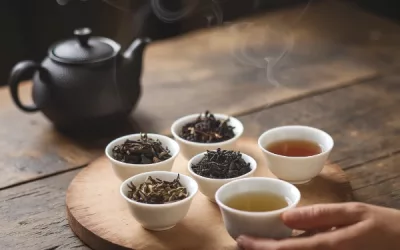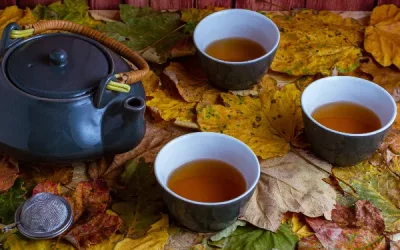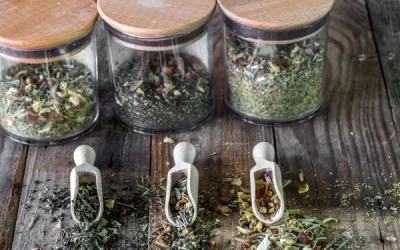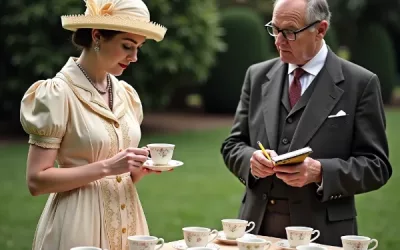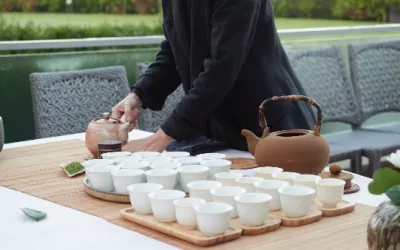Have you ever wondered why some cups of tea leave you feeling enchanted, while others miss the mark completely? Brewing loose-leaf tea is both an art and a science, essential for unlocking the full potential of flavours and aromas. As more tea lovers seek to refine their brewing techniques, mastering the right equipment, steeping times, and storage methods becomes crucial. This guide will walk you through every step of brewing loose-leaf tea perfectly, ensuring you savour each delightful sip.
Table of Content
- What equipment do I need to brew loose-leaf tea?
- How do I choose the right loose-leaf tea?
- What is the ideal water temperature for brewing loose-leaf tea?
- How long should I steep loose-leaf tea?
- How do I measure the right amount of loose-leaf tea?
- What are common mistakes to avoid when brewing loose-leaf tea?
- How can I customise my loose-leaf tea experience?
- Where should I store my loose-leaf tea?
- Conclusion
What equipment do I need to brew loose-leaf tea?
Brewing loose-leaf tea can be an enjoyable and soothing ritual, but you need the right equipment to get the best results. Essential items include a tea infuser, teapot, kettle, measuring spoon, and a cup. Each tool plays a specific role in the brewing process, enhancing both the flavour and the experience.
A tea infuser holds the loose leaves while allowing water to circulate around them. A teapot provides ample space for the leaves to unfurl, ensuring even steeping. Kettles come in various types that affect water temperature, crucial for different tea varieties. A measuring spoon ensures the right tea-to-water ratio, and your favourite cup completes the setup, making the experience personal.
What types of tea infusers are available?
Tea infusers come in several varieties, each with its own pros and cons.
- Ball Infusers: Small metal or mesh balls that hold tea leaves. Easy to use but may not allow full leaf expansion.
- Basket Infusers: Larger baskets that fit inside your teapot or mug. These offer more room for leaves to expand, ensuring better flavour.
- Silicone Infusers: Made from food-grade silicone, these come in fun shapes but can sometimes impart a slight flavour.
- Built-in Infuser Mugs: Mugs with built-in infusers are convenient, especially for single servings, though they offer less leaf expansion space.
Each type has its attributes, but the basket infuser usually provides the best flavour because it allows leaves to unfurl fully.
Why is a teapot preferred over a cup for brewing?
Using a teapot offers several advantages over brewing directly in a cup. Here’s why:
- Even Steeping: The larger space in a teapot allows leaves to unfurl completely, ensuring even flavour extraction.
- Heat Retention: Teapots, especially ceramic or cast iron ones, retain heat better, keeping your tea warm for longer.
- Serving Multiple Cups: Teapots make it easier to brew larger quantities, ideal when serving more than one person.
- Aesthetic Appeal: Teapots add a touch of elegance to the tea-drinking experience, making it feel more special.
Brewing in a teapot usually results in a more balanced, aromatic cup of tea, enhancing the overall enjoyment.
How does the kettle type affect water temperature?
The type of kettle you use can significantly impact the water temperature, which is crucial for brewing different types of tea.
- Stovetop Kettles: These allow you to manually control the heating process, making it easier to achieve the desired temperature.
- Electric Kettles with Temperature Settings: Ideal for precision, these kettles let you select exact temperatures, useful for delicate teas like green or white.
- Gooseneck Kettles: These offer precise pouring, better for controlled steeping, especially in tea ceremonies.
- Traditional Kettles: Simple but functional, though they may lack precise temperature control.
Different teas require different water temperatures: green and white teas need cooler water, while black and herbal teas benefit from boiling water. The right kettle helps you achieve this with ease.
In the early 19th century, Anna, the Duchess of Bedford, popularised the afternoon tea ritual in Britain. Bored with the long gap between lunch and dinner, she requested a pot of tea and light snacks to be brought to her room in the late afternoon.
This simple routine soon became a social event, with friends joining her for a cup of tea and a chat. This tradition spread quickly, making teapots and their companion tools household essentials across Britain, and eventually the world.
I remember the first time I tried brewing loose-leaf tea. I was a bit overwhelmed with all the equipment choices. I bought a small ball infuser and brewed it in a cup. While the tea tasted fine, it wasn’t until I invested in a proper teapot and a basket infuser that I truly appreciated the depth and richness of flavours. Now, each tea session feels like a mini celebration, a peaceful pause in my day.
How do I choose the right loose-leaf tea?
Choosing the right loose-leaf tea starts with understanding your personal taste preferences and how different teas can cater to those tastes. There is a broad spectrum of teas, each with unique flavour profiles and brewing requirements. Knowing a bit about each type can help guide you towards an enjoyable experience.
Loose-leaf tea can be a delightful experience if you take the time to explore different types. You can find teas that are light and floral, robust and malty, or even smoky and earthy. Understanding these nuances can enhance your tea-drinking journey.
Types of loose-leaf tea and their characteristics
To help you decide, here is a table that outlines different types of loose-leaf teas, their flavour profiles, and the ideal brewing conditions for each. This table will help you make an informed choice based on your taste preferences:
| Tea Type | Flavour Profile | Ideal Brewing Temperature and Time |
|---|---|---|
| Green Tea | Grassy, fresh, sometimes sweet | 75-80°C, 2-3 minutes |
| Black Tea | Bold, malty, full-bodied | 90-100°C, 3-5 minutes |
| White Tea | Delicate, floral, sweet | 70-75°C, 4-5 minutes |
| Oolong Tea | Floral, fruity, sometimes toasty | 85-95°C, 3-5 minutes |
| Pu-erh Tea | Earthy, rich, sometimes smoky | 90-100°C, 4-5 minutes |
| Herbal Tea | Varies (e.g., minty, citrusy) | 95-100°C, 5-7 minutes |
| Rooibos Tea | Nutty, sweet, woody | 95-100°C, 5-7 minutes |
Using this table is simple:
- Identify the flavour profile that intrigues you.
- Look at the corresponding tea type.
- Follow the ideal brewing temperature and time for the best experience.
Understanding flavour profiles and brewing techniques
Each type of loose-leaf tea has a unique set of characteristics. Here are more details to guide your choices:
- Green Tea: Offers a fresh and sometimes sweet flavour. Ideal for those who enjoy lighter, more refreshing drinks.
- Black Tea: Known for its strong, robust flavour, perfect for a morning boost.
- White Tea: Provides a delicate and floral taste, ideal for a gentle, soothing experience.
- Oolong Tea: Strikes a balance with its floral and fruity notes, sometimes with a toasty finish.
- Pu-erh Tea: Rich and earthy, perfect for those who enjoy bold flavours.
- Herbal Tea: Varies widely but can include minty, citrusy, or spicy notes. Great for a caffeine-free option.
- Rooibos Tea: Nutty and sweet with a woody undertone. Another caffeine-free choice.
When brewing, always:
- Use fresh, cold water.
- Preheat your teapot or cup.
- Follow the recommended temperature and brewing time to avoid bitterness or weak flavour.
Tips for enhancing your tea experience
To fully enjoy the world of loose-leaf tea, consider these tips:
- Experiment with different tea types to find your favourites.
- Adjust brewing times slightly to tailor the strength to your liking.
- Use a tea infuser to allow the leaves to expand and release their full flavour.
- Store your teas in a cool, dry place to maintain their freshness.
Loose-leaf tea brewing can be a rewarding hobby. The more you experiment, the more you’ll learn about your preferences.
In the 17th century, tea was a prized commodity in Britain. The East India Company imported it from China, creating a luxurious demand. In 1660, Charles II married a Portuguese princess, Catherine of Braganza, who loved tea. She made it popular in the English court, which then trickled down to society. This historical shift made tea a central part of British culture.
When I first started brewing loose-leaf tea, I was overwhelmed by the options. I tried a few varieties, like green and black teas. I found the brewing table handy for getting the perfect cup. My favourite ended up being oolong, as I loved its complex, floral notes. Now, tea brewing is a cherished daily ritual, a moment of calm in my busy day.
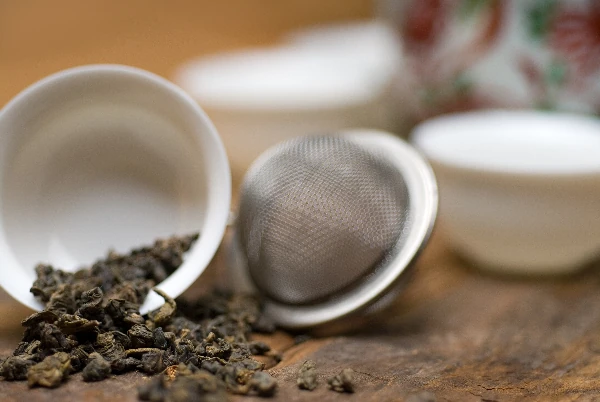
What is the ideal water temperature for brewing loose-leaf tea?
Water temperature isn’t just about turning a kettle on and hoping for the best. When it comes to loose leaf tea brewing, it’s a game-changer, a flavour extractor, and frankly, a make-or-break scenario.
Let’s dive into the specifics of getting it right, starting with different types of tea and their temperature needs. You’ve got green tea, which likes to keep it cool and mild, usually between 70-80°C; black tea, an old-school friend that enjoys a hotter bath at 95-100°C; and let’s not forget our fancy friend, oolong, which likes it somewhere in between, around 80-90°C.
Why the fuss about these ranges? Because temperamental teas need their perfect temperature to release all those lovely flavours without turning bitter or too weak.
Let’s get technical for a moment. Heat affects how the leaves open up and release their goodness into your cup. Too hot, and you’ll scorch those delicate leaves, making your brew taste like an old shoe.
Too cold, and you might as well be drinking scented water. This is why getting the temperature right is crucial for optimal flavour extraction. Different teas have various compounds that react to temperature uniquely. Bottom line: it’s all about coaxing the perfect brew out of those leaves.
How does temperature affect the tea’s flavour?
When it comes to brewing loose-leaf tea, the temperature of the water is as vital as the tea leaves themselves. Hot water facilitates the extraction of polyphenols and essential oils, which contribute to the tea’s aroma and taste. But go overboard, and you might end up extracting too many tannins, making the tea bitter and astringent.
- Overheating green tea, for instance, results in a bitter, spinach-like flavour.
- Oolong at the wrong range loses its complex, layered taste notes.
- Black tea brewed too cool might come out lacking boldness and depth.
- White teas, which are very delicate, get completely ruined at high temperatures, leaving you with a bland cup.
In a nutshell, temperature controls the balance of flavours. It’s about making sure that each sip is a delightful mix of the right notes.
What are the best practices for measuring water temperature?
To nail the perfect brew every time, you need to know how to measure your water temperature effectively. There are a few methods to ensure you’re not winging it:
- Thermometers: A digital thermometer is your best mate here. Quick, accurate, and reliable.
- Electric Kettles: Some come with preset temperature options for different types of tea.
- Manual Gauging: If you’re feeling traditional, you might pour boiling water, then let it sit for a bit—about 5 minutes should cool it down by roughly 10-15°C.
- Colour and Sound: This is for the pros. As water heats, it makes a series of noise levels and forms different bubble patterns indicating various stages.
Temperature control is vital for achieving consistency in your brew, ensuring every pot is just as delicious as the last.
Can I use tap water for brewing?
Now, let’s tackle the water itself. Tap water can be a hit or miss—depends on where you live and the quality of your municipal water. Some places have hard water, loaded with minerals that may dull the tea’s crisp flavours. Others might have chlorinated water, adding an unwelcome chemical taste.
- Filtered Water: A carbon-filtered pitcher can remove chlorine and some impurities.
- Spring Water: Some purists swear by bottled spring water for its consistent mineral content.
- Distilled Water: Avoid this. It lacks the minerals needed to enhance the tea flavours properly.
- Boiling First: If you’re stuck with only tap water, boiling it first can help eliminate some of the unwanted flavours.
Pick your water wisely. After all, tea is 99% H2O, so it can make or break your brew.
Many moons ago, in the 1820s, Anna, the Duchess of Bedford, started the British tradition of afternoon tea due to those dreadful long gaps between meals. She wasn’t just pouring water willy-nilly into a pot.
She paid attention to water quality and temperature. Her insistence on these details is why afternoon tea became an art and celebrated social event. Temperature and the type of water have always been vital for a perfect cup, even back in the day when your teapot was your best friend in high society.
So, whether you’re sipping a Zen-inducing green tea or a robust black tea to get you going, remember that water temperature and quality are key to unlocking the best from those lovely leaves. Cheers!
How long should I steep loose-leaf tea?
Steeping loose-leaf tea is akin to fine-tuning a musical instrument – just the right amount of time makes your tea sing. Too little, and you’ve got a weak serenade that’s more bore than score. Too much, and you’ve brewed yourself a bitter orchestra mutiny. Let’s dive into the nuances of steeping because, believe it or not, not all teas like to linger in hot water.
Steeping times aren’t a one-size-fits-all situation. Each variety of tea – black, green, oolong – has its own optimal steeping duration. Then, there’s the matter of personal taste. Some like their tea robust and intense, others prefer a more delicate flavour.
Adjusting steeping times to suit your palate is entirely possible. Plus, let’s not forget over-steeping – the perilous path that leads to a flavour catastrophe. We’ll tackle all these aspects, so you can sip your tea with confidence and avoid any bitter disappointments.
What are the recommended steeping times for various teas?
Tea is as diverse as a mixed bag of British weather – but each type thrives under specific conditions. Knowing the recommended steeping times is your ticket to a consistently delightful cuppa.
- Black Tea: 3-5 minutes. Bold and rich, black tea needs a little more time to release its full array of flavours.
- Green Tea: 1-3 minutes. Treat it gently, it’s delicate and can turn bitter if you overdo it.
- Oolong Tea: 3-5 minutes. Somewhere in between black and green in strength, it deserves a balanced approach.
- White Tea: 4-5 minutes. Soft and subtle, it requires patient steeping.
- Herbal Tea: 5-7 minutes. Not technically tea, but delightful nonetheless, herbal blends demand a longer infusion to get the full burst of flavour.
Time recommendations are guidelines, not the law. If you fancy your green tea a bit stronger, go ahead and steep it for an extra 30 seconds. Your taste buds, your rules.
How can I prevent over-steeping?
Over-steeping is the nemesis of good tea. Avoiding it is a matter of vigilance and technique.
- Use a Timer: You’re not baking a cake, but a simple kitchen timer or a phone alarm can be your best friend.
- Pay Attention to Water Temperature: Keep water temp in check. Boiling water’s great for black tea but can ruin green or white tea.
- Quality Over Quantity: Use the right amount of tea leaves. Too many leaves can overpower your brew even in a short time.
- Dedicated Steepers: Invest in a teapot or infuser with a removable basket. Once time’s up, pull the leaves out.
- Taste Test: If unsure, start tasting your brew halfway through the recommended time. It’ll give insight into what works best for your palate.
These tips will save you from experiencing the wretched fate of mouth-puckering, astringent tea.
Is it possible to re-steep loose-leaf tea?
Re-steeping loose-leaf tea is not only possible, it’s an art! The flavour of good quality loose-leaf tea evolves with each steep, becoming more nuanced and sometimes even better.
- Green Tea: Perfect for re-steeping. A second steep can often bring out new flavours.
- Oolong Tea: Built for multiple infusions. Each steep reveals different layers of its complex profile.
- Black Tea: More temperamental. Some high-quality blacks can go for a second round, but the further you go, the feebler they become.
- White Tea: Generally good for 2-3 steepings. It’s mild, so each infusion feels like a fresh, light breeze.
- Pu-erh Tea: The heavyweight champion of re-steeping. A single set of leaves can last multiple brews, delivering a symphony of evolving tastes.
Re-steeping lets you stretch your tea leaves to their full potential. It’s like using a sponge – you wring out every little bit of goodness.
During the Tang Dynasty in China, tea was so revered that the poet Lu Tong’s “Seven Bowls of Tea” became quite famous. In it, he describes the transformative experience of drinking multiple bowls of tea.
It’s said his seventh bowl would connect him to the divine. His poetic musings align with the philosophy of re-steeping loose-leaf tea – each brew offering new insights and enhanced enjoyment. If ancient Chinese poets saw the value in re-steeping, surely, it’s something worth trying in your own modern-day tea rituals.
How do I measure the right amount of loose-leaf tea?
When it comes to brewing loose-leaf tea, precision is key. You wouldn’t want to drink something that tastes like a grassy pond or, on the flip side, like bitter sludge. The right measurements can make or break your brew. Now, let’s dive into the specifics.
Standard Measurements
Determining the correct amount of loose-leaf tea usually involves a standard measurement. For most teas, a good rule of thumb is:
- 1 teaspoon per 8 ounces of water for stronger teas like black or oolong.
- For delicate teas like green or white, 1 teaspoon per 10 ounces of water.
- Herbal teas might need a little more—go for 1.5 teaspoons per 8 ounces of water.
This guideline ensures you’re not underwhelming or overwhelming your taste buds. But wait, there’s more to consider.
Factors Influencing Tea Quantity
Several factors come into play when brewing the perfect pot—or cup—of tea. They include:
- Tea Type: Different types have varying densities and leaf sizes.
- Desired Strength: Preference varies. Some like their tea robust, others more mellow.
- Leaf Expansion: Some teas expand significantly when steeped.
- Water Quality: Yes, the type of water you use can impact the amount of tea you need.
- Teapot Size: Big teapot or small infuser? Measurements change accordingly.
Not only do these factors determine the amount of tea to use, but they also impact flavour and overall enjoyment.
Tips for Adjusting Strength
Feeling adventurous? Adjusting the tea strength isn’t rocket science. To modify the strength without messing up your entire brew:
- Increase or decrease the amount of tea slowly.
- Steep longer for more strength (but be cautious of bitterness).
- Cut back on steeping time if your tea is too bold.
- Mix different tea types for a unique taste.
These tweaks allow for personalisation, making your tea experience your own. So, let’s tackle some specific questions you might have.
How much loose-leaf tea should I use per cup?
Great question! As a starting point:
- Black Tea: 1 teaspoon per 8 ounces
- Green Tea: 1 teaspoon per 10 ounces
- Herbal Teas: 1.5 teaspoons per 8 ounces
- Oolong Tea: 1 teaspoon per 8 ounces
- White Tea: 1 teaspoon per 10 ounces
Basic enough? Now, keep in mind these are starting points. Don’t be shy in tweaking the measurements based on your taste preferences.
What factors should I consider when measuring tea?
Aside from the standard measurements, consider the following:
- Tea Density: Light, fluffy teas need more volume compared to dense, compressed varieties.
- Strength Preference: Personal taste dictates if you need more or less.
- Leaf Size and Shape: Big leaf teas might require more as they occupy more space but weigh less.
- Brewing Time and Temperature: Both can affect how much tea to use.
- Type of Water: Filtered or spring water enhances flavour, potentially requiring less tea.
By keeping these factors in mind, you can tailor your tea-brewing to perfection.
Can I use a kitchen scale for measuring tea?
Absolutely, you can! A kitchen scale offers precision that’s hard to beat:
- Accuracy: Perfect for recipes that require exact measurements.
- Consistency: Ensures you replicate your perfect cup every time.
- Ease: Especially useful for teas where a teaspoon might not cut it due to leaf size.
For example, use:
- 1 gram per 8 ounces for most teas.
- 1.5 grams per 10 ounces for lighter teas.
Gone are the days of eyeballing it. Let’s be scientific about our tea!
Measuring loose-leaf tea might seem trivial, but consistency ensures you savour the intricacies of each type. Speaking of precision and consistency, once upon a time in the Song Dynasty, tea brewing was considered an art; emperors would host competitions. Brewers were judged on their ability to make the perfect cup, down to the last gram of tea. So, each time you measure and brew, consider yourself part of an ancient and refined tradition.
And there you have it—measure right, brew well, and enjoy the perfect cup, every time. Cheers!
What are common mistakes to avoid when brewing loose-leaf tea?
Brewing loose-leaf tea may seem like an easy task, but even the most experienced tea-lovers can slip up. Let’s dissect some common pitfalls: incorrect water temperature, improper steeping times, using stale tea, and not measuring tea accurately. Consider this as your brew-fool-proof guide!
Nothing’s worse than making a nice cup of tea, only to have it taste like you’ve diluted sawdust. A little attention to detail can save you from that nightmare. Now, let’s dive into what happens when you ignore the unspoken rules of tea brewing.
What are the consequences of using the wrong temperature?
Temperature wielders, beware! Brew your tea at the wrong temperature, and you might as well be tossing it down the drain.
- Too Hot: Boiling water tends to scald delicate leaves, especially green or white teas. This results in a bitter, astringent flavour – basically like sipping on liquid socks.
- Too Cold: Under-heating water means the full spectrum of flavours fails to make an appearance. You’ll get a bland, disappointing cup – cheaper but no less disappointing than lukewarm soup.
- Accuracy: Thermometers and temperature control kettles are your friends here. Precision makes a difference.
- Ideal Ranges: Green tea thrives at around 70-80°C, while black tea loves the rolling boil (100°C). Each type has its sweet spot – find it, and you’ll be rewarded.
- Consistency: Keeping the temperature consistent ensures your tea tastes just as great every time. There’s no need for surprises in your morning pot.
Truth is, water temperature can make or break your tea-drinking experience. Nail it, and you’re halfway to tea heaven.
How can stale tea affect the brewing process?
Stale tea leaves are the stuff of nightmares. Throw them in the bin where they belong.
- Loss of Flavour: Over time, tea loses its natural oils, leaving you with a bland concoction. It’s like drinking cardboard.
- Aroma: Fresh tea has a potent aroma; stale tea smells lifeless, like damp paper or the inside of a forgotten drawer.
- Colour: Expect a dull, uninspiring colour from old tea leaves, nothing like the vibrant hues we love.
- Health Benefits: Fresh tea is loaded with antioxidants. Stale tea, not so much. You’re basically just creating a bitter soup.
- Storage Tips: Airtight containers, cool and dark places – two golden rules for keeping tea fresh.
Treat your tea like fine wine. Keep it fresh, and it’ll repay you in spades.
Why is accurate measurement crucial for flavour?
Eyeballing your tea leaves? Get a grip and grab a scale or a proper teaspoon.
- Consistency: Measuring your tea ensures you’re getting the same strength every time. No one likes a surprise when it comes to caffeine.
- Flavour Profile: Different teas require different amounts. Too much or too little can overwhelm or underwhelm the taste buds.
- Potency: Stronger isn’t always better. Too many leaves equate to bitterness, weaker ones lead to blandness. Balance is key.
- Type of Tea: Delicate teas like oolong need a specific amount to reveal their complex notes. Heavy-handed measures can ruin the experience.
- Experimentation: Accurate measurement helps in experimenting with different teas. Once you find your sweet spot, it’s easy to replicate.
Accurate measurement is the unsung hero of a well-brewed cup. Precision here ensures you maximise the joy only a perfect cuppa can bring.
Let’s hop on a time machine for a moment. Back in the 18th century, the British East India Company was importing tea by the boatload. Those Brits loved their tea so much that they invented ways to store it in elaborate, lock-and-keyed tea caddies – all to prevent the help from pilfering their precious stash. Take a leaf out of their book (pun intended). Keep your tea fresh and measure it right; you’ll avoid the dreary fate of stale, poorly brewed tea!
So there you have it. With attention to temperature, freshness, and measurement, you’ll avoid becoming the butt of jokes in the tea-drinking world. Cheers to better brews!
How can I customise my loose-leaf tea experience?
Want to turn your cup of tea from a mundane ritual into a personalised masterpiece? Welcome to the world of customising loose-leaf tea. It’s like being the mad scientist of your tea station. The basics are pretty straightforward, but where it really gets fun is in experimenting with blends, tweaking the brewing parameters, and throwing in some flavour enhancers. You’re essentially the director of your own tea symphony. Let’s dig into how you can jazz up your drink.
Experimenting with blends is your first stop on this flavour adventure. It’s like playing mixologist, but with tea leaves. Ever imagine combining the tranquillity of chamomile with the zestiness of citrus? Well, dream no more. Blending is all about finding what suits your palate.
Next up, adjusting your brewing parameters. Think of this as fine-tuning your guitar before a gig. The right water temperature, steeping time, and tea-to-water ratio can mean the difference between divine nectar and bitter disappointment.
And if you’re still craving more? It’s time for some flavour enhancers. Think spices, sweeteners, and even fruits. Let’s dissect these components a bit.
What are some popular tea blends to try?
So, you’re ready to dive into blends, but where to start? There are combinations galore that can make your taste buds do a happy dance. Whether you’re into robust flavours or delicate notes, there’s a blend with your name on it.
- Earl Grey and Lavender: This blend mixes black tea with lavender, giving a floral twist to a classic.
- Green Tea and Mint: Refreshing and invigorating, perfect for a mid-day pick-me-up.
- Chai Masala: Spiced black tea that warms you from the inside out, like a hug in a mug.
- Chamomile and Lemongrass: Calming and zesty, it’s great for winding down.
- Rooibos and Vanilla: A caffeine-free option that’s naturally sweet and comforting.
Getting the proportions right is crucial. Too much lavender in your Earl Grey can make you feel like you’re drinking a bottle of perfume, while too little mint can leave your green tea bland.
How can I enhance the flavour of my tea?
You’ve got your blend, now let’s give it some pizzazz. Enhancing tea’s flavour can be as simple or intricate as you want it to be, just like accessorising an outfit.
- Sweeteners: Honey, agave syrup, or a dash of stevia.
- Spices: Cinnamon, cardamom, or a touch of ginger.
- Citrus: Lemon, lime, or even orange zest.
- Herbs: Mint, rosemary, or basil for a unique twist.
- Fruits: Berries, apple slices, or dried apricots.
These additions don’t just enhance flavour but also add aroma, making your tea-drinking experience multi-sensory. Just remember, less is often more! A slight pinch of cinnamon can elevate your tea, while a handful can overwhelm it.
What are the benefits of customising tea?
You may wonder why go through the hassle of customising your tea. Well, it’s not just about taste. There’s a plethora of perks that make this endeavour worthwhile.
- Health Benefits: Custom blends can offer added health benefits depending on your chosen ingredients, like ginger for digestion.
- Personal Satisfaction: Creating something that’s uniquely yours can be immensely satisfying.
- Relaxation: Tinkering with blends and flavours can be a therapeutic activity.
- Social Aspect: It’s a great conversation starter and makes for an impressive party trick.
- Taste Perfection: Tailoring your tea ensures it’s brewed exactly how you like it.
You’re not just making a beverage; you’re creating an experience. Customising allows you to explore various health benefits, dig deep into the art of brewing, and most importantly, enjoy a cup that matches your exact taste profile.
Back in the day, Japanese tea masters understood the importance of customisation long before we did. Take the 16th-century tea master Sen no Rikyū, for example. He elevated the Japanese tea ceremony (or Chanoyu) to an art form by focusing on the presentation, blending, and brewing techniques.
Everything from the tea utensils to the configuration of the tea room was meticulously chosen, reflecting his values of simplicity, rustic beauty, and understated elegance. Rikyū’s approach wasn’t just about drinking tea; it was about experiencing it fully with mindfulness and intention—an idea still influential in tea culture today. So, why not channel a bit of that tea master spirit in your own brewing escapades?
Where should I store my loose-leaf tea?
Alright, tea lover, so you’ve decided to elevate your tea game by diving into the world of loose leaf tea brewing. Excellent choice! Now, before you start brewing that perfect cup, let’s talk about where to store your prized leaves. Trust me, it’s more important than you might think.
Loose-leaf tea is delicate, like your nan’s china collection. If you treat it right, you’ll be rewarded with an aromatic, flavourful brew. Treat it wrong, and you’ll be sipping a cup of regret.
How does storage affect tea freshness?
Storage is the guardian of tea’s flavour fortress. If you get this wrong, you risk turning those fragrant leaves into a sad mess that tastes like cardboard. Tea is sensitive to:
- Light: Direct sunlight is like a Death Star for tea. It deteriorates the leaves and zaps the flavour.
- Air: Exposing tea to air means it oxidises and loses its oomph.
- Moisture: Tea leaves and water are best friends—only when you’re brewing. Otherwise, moisture is the enemy.
- Odours: Loose-leaf tea is like a sponge for any nearby smells. Unless you fancy mint-flavoured Earl Grey, keep it away from strong scents.
So, treat your tea with care, and it will return the favour by staying fresh and vibrant, just the way you like it.
What types of containers are best for tea storage?
When it comes to containers, you need to be picky. Here’s what to look for:
- Airtight containers: These keep the oxygen out and the flavours in. Think mason jars, tins with tight lids, or specialised tea canisters.
- Opaque materials: Remember, light is the enemy. Use containers that light can’t peep through. Dark coloured tins or even opaque ceramic jars work wonders.
- Non-reactive surfaces: Tea can pick up unwanted flavours from certain materials. Stick with glass, ceramic, or food-grade stainless steel.
- Vacuum-sealed bags: These are great for keeping air away from the leaves, prolonging their lifespan.
Avoid clear jars displayed on your kitchen counter like a trendy Instagram post. Even though they look cool, they sabotage the flavour by letting in light and air.
Can I store tea in the fridge?
Let’s clear this up once and for all: Storing tea in the fridge is like sticking your prized comic book collection in the garden shed. Just don’t do it.
- Temperature fluctuations: Opening and closing the fridge door means constant changes in temperature, which your tea hates.
- Moisture: Fridges are cold, but they also have moisture. Moisture and tea leaves? A bad mix unless your goal is mouldy leaves.
- Odour absorption: Your mint tea doesn’t want to make friends with last night’s garlic pasta.
Instead, find a cool, dark cupboard away from heat sources like your oven or the sun-blasted kitchen window.
In medieval China, tea was such a prized possession that special caddies were commissioned, often carved from jade or made from precious metals. These containers were kept in climate-controlled rooms to maintain quality. Imagine going to those lengths today! While jade might be overkill, your tea still deserves a good spot to stay fresh and fabulous.
Conclusion
As I reflect on the intricate art of loose-leaf tea brewing, I find that it truly is a journey of both science and personal expression. Throughout this guide, we’ve explored the essential equipment required—like proper infusers and teapots, which foster the delicate infusion of flavours—while also emphasising the importance of choosing the right type of tea to suit your taste.
Understanding the nuances of water temperature and steeping time is crucial, as these factors significantly influence the final cup’s flavour, ensuring that every sip is a delightful experience.
The significance of these observations extends beyond merely making a cup of tea; it highlights the value of mindfulness and intention in our daily rituals. By actively engaging in the process—from measuring the right amount of tea to experimenting with flavour enhancers—we can transform an ordinary moment into a truly satisfying one. And it doesn’t stop there; being aware of common mistakes to avoid and adopting best practices for tea storage can elevate our brewing skills even further.
As we journey forward, I encourage you to experiment with different tea blends and brewing techniques, tailoring each experience to reflect your tastes and preferences. What if you were to keep a tea journal to track your discoveries?
After all, the world of loose-leaf tea offers endless possibilities waiting to be explored. Remember, as the legendary tea master Lu Yu said, “He who brews tea with the right spirit will find it a most delightful remedy.” So, let us raise our cups to a brewing process that promises not just sustenance, but also joy and connection. Happy steeping!


